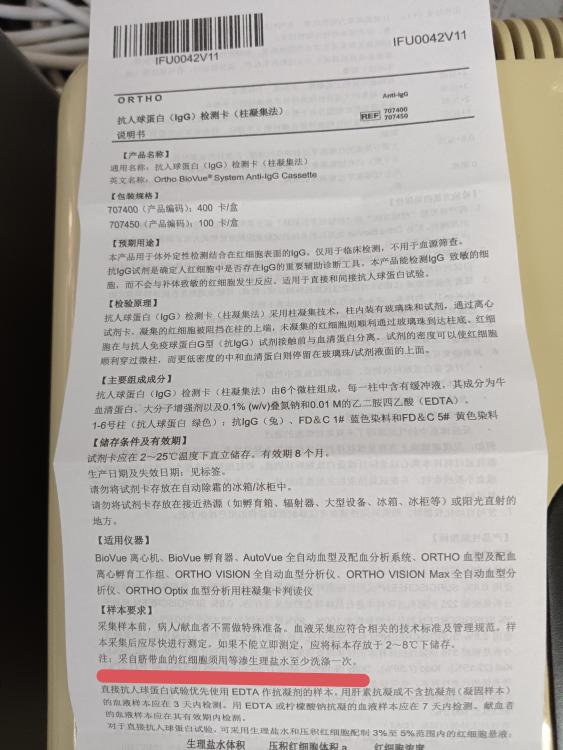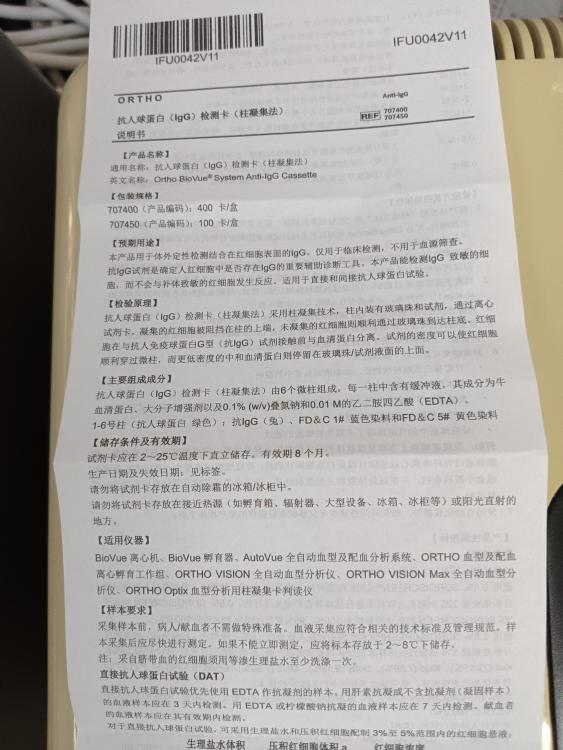Everything posted by Yanxia
-
Anti D level in 2nd pregnancy
Just my guess, is there any possibilities of fetus D pos cells bind partof the antibodies?
-
What problems in transfusion services that you encountered that is worth doing a study?
We have encountered a patient who produced auto anti-A(or A1,sorry I didn't identify it).
-
Cord Blood testing on gel
Sorry,I can't find the English version.The underlined sentence means the cord blood cells needed to be washed at least once before testing.
-
Cord Blood testing on gel
- Cord Blood testing on gel
I am so lazy that I just checked our IgG card today . I noticed it said that cord blood need to be washed before testing. I am at home now, I will attach the package insert tomorrow.- Cord Blood testing on gel
I guess this may be caused by the Wharton's Jelly which can cause rouleaux formation of the cord cells. For the gel technique, it is good to test the adult cells without washing, but for the cord cells, maybe the Wharton's Jelly block antigens on the cells' surface. I noticed that patients suffer from Multiple myeloma will not show false positive reaction in gel, but saddly I have not confirmed if there are false negative reactons.- Prenatal Antibody Titers
I prefer the each individual one policy. Because we can not make sure the baby has the combined antigens.- Mock-up cases
Thanks for your sharing, Malcolm. In the course of reading the cases above, I encountered many problems which resolved by checking on books. This is a very impressive way to absorb new knowledge. As a hospital blood bank worker, I rarely have chances to get access to thoes cases.- A 10month A pos baby with anti- A
Here is a follow up. The baby had tested with anti-A on 27, April and transfused with O washed cells the same day, but on 10, May she had no anti-A and received A type packed red cells with no transfusion reaction. She has stoped feeding on her mother's milk for 14 days. I tried to persuade her mother to do some tests. The results came out and she has no anemia, with normal reticulocyte count and percentage. Her bilirubin and LDH are normal too. But she has not tested her haptoglobin. She has not received any blood transfusion and IVIG. She just diagnosed with slight anemia during pregnancy and after birth. She had taken iron supplements during pregnancy,. This is her eventh pregnancies and the third baby, she had several miscarriages. She told me her case seems like a mystery both to her and the doctors she know. She just want to know if she is ok and the baby will be healthy in the future.- A 10month A pos baby with anti- A
The baby is discharged now, we cannot test the mother anymore, what a pity.- A 10month A pos baby with anti- A
She is still breast feeding the baby, and looks healthy.- A 10month A pos baby with anti- A
Thank you very much, Arno. Only one question left, why does the mom asymptomatic even with auto anti-A. We have encountered another case of auto anti-A, that one need transfusion.- A 10month A pos baby with anti- A
Thanks, Malcom. 1. I am not sure it is.anti-A, not.anti-A1. I mathed 5 A donors with the patient and the reactions.are all positive(Maybe they all A1). It is my fault, I need to add A2 cells to make sure about it. 2. I searched about the FORS1 online, there are few papers I can find. I will try my books tomorrow. This.is the.first time I read this antigen. Is there any cross reaction between it and A( or A1) antigen? 3. There is an idea just poped on my mind, it maybe Tn. But I don't know if Tn can give so strong reaction with monoconal anti-A reagent.- A 10month A pos baby with anti- A
No, He has got nothing above. I guess the antobodies come from the mom, maybe from breast breeding , but have not heard about it before. Will the milk origined anotibodies come into the blood stream and be IgG?- A 10month A pos baby with anti- A
Thanks, sbbguy. At first I thought maybe the mom is A2 type, too. But she is A1 type with pos DAT due to IgG. I feel so confused.- A 10month A pos baby with anti- A
I have encountered a case, there was a 10 month baby boy, he was A type, but there was anti-A in his serum and on his red cells we also eluated anti-A. His mom was A type with auto anti-A. 1.I remember the books say maternal origin antibodies will disappear 6 monthes after birth, maybe the books are lying😃 or there are some other reasons. He was breast feeded. 2.His mom looks healthy even with auto anti-A, but the baby developed hemolysis, why? Thanks in advance for your help.- Anti-D in O positive patient, DAT+, no RhIg given
I was wondering why does she express D pos, if the allele can not encode D?- Transfusion Reactions:Hives
Thanks for your explanation. I guess there must be some measures be taken to prevent the opening system to be contaminated, would you please share it with me?- Transfusion Reactions:Hives
For resuming transfusion, do you mean resume the blood which caused reaction or another unit of blood?- Valid blood type
"2.7.6 Ael Under usual conditions Ael cells are not agglutinated by anti-A or -A,B, although they do bind these anti bodies, as demonstrated by adsorption and elution [298,337–339]. Saliva from Ael secretors contains H, but no A substance. Serum from Ael individuals usually contains anti-A1 and may also contain an anti body that agglutinates A2 cells [337,339]. No A transferase has been detected in Ael serum or red cell membranes [232,287–289]. Serum H-transferase is weaker than that found in A1 or A2 serum [289]. No example of Ael was found in testing 150000 French blood donors [283], but fifive were found among 400000 Chinese from Taiwan [328]. Ael appears to be inherited as a rare gene at the ABO locus [337–339]. As a result of allelic enhancement (Section 2.10.2), AelB cells may be weakly agglutinated by some mono clonal anti-A and may resemble B(A) phenotype [340]" The text above comes from Danels' HUMAN BLOOD GROUPS the second edition, page 36 If we just look at the forward group , we may identify it as type O, but because it has weaker anti-A, we do think it is not a normal reaction ,so we will do further investigation ,and then find out it has weak A antigens. It is important for transfusion and organ transplantation.- Valid blood type
I'm with galvania, we have identified a lot of subgroup patients based on the weaker reverse reactions. Such as A2,A3, Ax, Ael, Aend, and the same the Bsubgroup- Valid blood type
We require the reverse type to be 2+ or stronger in tube, because weaker reaction can mean subgroup or weak immunoglobulin.- Issue for the Identification of Antibodies
The possible antobodies are anti-E, V,K, Jsa and Lua, then I will pick some cells to test it and antigen typing the patient to confirm it.( Jsa and Lua pos cells are quite rare, so it is hard to get them, luckily they will not cause rapid hemolysis after transfusion, as for anti-V, the clinical significance is unknown.)- Issue for the Identification of Antibodies
From the second panel you posted, I think there are some specificity in the 37 and IAT phase, so my guessing it that there are not only cold auto that interfere with the reaction. I will do an auto-absorption in 4 drgess first( If this patient has not received transfused red cells pack in three months), then run panel using tube IAT. Just personal opinion, I am looking forward to learn from here.- B(A) and cisAB phenotypes
According to Human Blood Groups by Geoff Daniels, second edition, 40-42 Most B(A) have strong or normal B antigens, and most CisAB have weaker B antigens. - Cord Blood testing on gel
Important Information
We have placed cookies on your device to help make this website better. You can adjust your cookie settings, otherwise we'll assume you're okay to continue.





